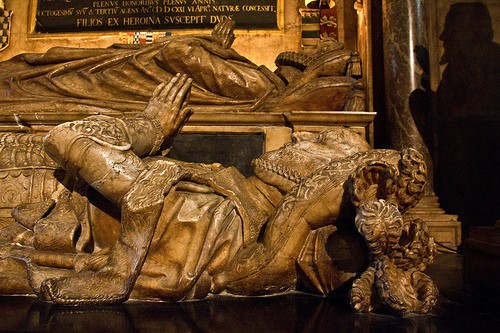Katherine Grey: Life Story
Chapter 16 : The End
Katherine was to stay at Ingatestone for two years, before being moved in May 1566 to the home of Sir John Wentworth at Gosfield Hall, a distant cousin of Hertford’s. Sir John was not happy at the arrival of such a troublesome prisoner. Well into his seventies, he declared that he would rather be imprisoned himself than be custodian of Katherine. He pointed out how easy it would be for her to escape. Katherine did not attempt to escape, but she and Hertford still corresponded.
During 1566, calls for the succession to be assured were again brought forward by Parliament, with Katherine still favoured by the majority of the Protestant faction - although not all. Dudley was inclined to support the claims of Mary, Queen of Scots, who now had a son. Elizabeth, with her usual skill, managed to evade the issue yet again.
Then came the bombshell that overshadowed politics in England and Scotland for the next twenty-five years. The Queen of Scots’ husband, Lord Darnley, had been murdered, and Mary deposed, accused of complicity in his death. Yet another wave of uncertainty over the succession washed over Elizabeth and her ministers, with the rival factions supporting Katherine and Mary each pushing their own candidate forward. Meanwhile, Katherine herself was still isolated in Essex, although she was now permitted to enjoy the rents of some of the lands previously owned by her parents.
By the end of 1567, poor Sir John Wentworth had died, and
his widow and executor were at their wits’ end with no orders as to what to do
with their young prisoner. She was moved to even stricter confinement at
Cockfield Hall in Suffolk, under the wardenship of a protesting Sir Owen Hopton.
As soon as he saw her, Hopton realised that Katherine was ill. He requested that the Queen’s own doctor, Dr Symonds, be sent to treat her. Katherine however, did not want to get better. She lay in bed, depressed, not eating and with no hopes for the future. She listened to the psalms being read to her and although the Hoptons exhorted her to brace up and take comfort, she would not.
At the end, she confirmed the Protestant faith in which she had been brought up, saying that ‘[she] believe[d] to be saved by the death of Christ.’She then sent a last request to the Queen, to hold her children blameless for her own offences, and to ask Elizabeth to set Hertford free. To her husband, for so she was certain that he was, she left the diamond betrothal ring, her wedding ring, and a ring with a picture of herself set in it. Katherine died on 27th January, 1568, at the age of twenty-eight.
Elizabeth made a polite show of sorrow, and ordered a suitably grand funeral, complete with Katherine’s arms of England, quartered with France, differenced for her descent. A sum of £140 was sent to Hopton for Katherine’s final expenses and the costs of the funeral. Katherine was buried in the parish church of Yoxford, rather than in Westminster Abbey with her mother.
Hertford, surprisingly, seems to have learnt little from his experiences. Although after Katherine’s death he was released and restored to the normal activities of a peer of the realm, he made two further secret marriages and had another couple of sojourns in the Tower.
After the accession of James, Hertford managed, in 1608, to track down the clergyman who had married him to Katherine. It seems extraordinarily unlikely that the man, who had not come forward previously, should both still be alive, and identifiable. A suspicious mind might think that either Hertford knew where he was all along, or that he found someone willing to play the part.
The incentive may have been his grand-son’s secret plan to marry the Lady Arbella Stuart, who had a strong claim to the throne. Hertford died in 1621, having outlived Katherine by over 50 years. Their grandson had Katherine’s body exhumed, and she now rests, finally at Hertford’s side, in a grand tomb in Salisbury Cathedral.

Lady Katherine Grey
Family Tree


